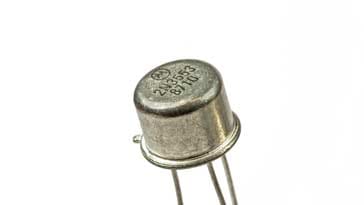Common Emitter Transistor Gain Equations & Theory
Transistor gain theory with derivations for transistor gain starting with Kirchoff’s principles applied to the common emitter transistor configuration.
Home » Electronic components » this page
Transistor Tutorial Includes:
Transistor basics
Gain: Hfe, hfe & Beta
Transistor specifications
BJT Early Effect
Transistor and diode numbering codes
Choosing replacement transistors
Transistor component data:
Transistor component data
It is possible to gain some more insight into the operation of the transistor by looking a little further into the mathematics behind the operation of the device.
First the theory and gain will be examined for the common emitter circuit, where the emitter is common to both input and output circuits.

Transistor gain derivation
It is sometimes useful to use some simple transistor theory to derive the gain calculations and formulas.
The most widely used circuit is the common emitter where the emitter is common to both input and output circuits.

Also figures for transistor gain including Β and H Hfe, hfe refer to the common emitter circuit.
For any transistor circuit we find that the following simple formula expresses the currents flowing into the transistor:
Where
Ic = collector current
α = Fraction of emitter carriers reaching collector, typically in the region 0.95 to 0.99
Ie = emitter current
Ico = Reverse current from base to collector
Eliminating Ie we are able to develop the following formula:
The factor α / (1 - α) is called Β Beta which is the common emitter current gain. For example if α = 0.98, then the transistor Beta Β can be calculated to be 49.
Replacing it is possible to determine the collector current, Ic in the equation below:
Assuming the reverse current is low and can be ignored we see:
Large & small signal gain theory
The gain of a transistor varies slightly according to the signal applied and where it is on the operating curve.
As a result of this, the calculations and theory can be adapted to accommodate this. In fact often two figures are quoted. Both Hfe, hfe are seen in data sheets for transistors, Hfe being the DC gain, and hfe being the small signal gain.
The datasheets normally define the test conditions under which the tests were made, and in this way it is possible to interpret the performance and compare different devices.
The equations for the different conditions can be given as:
It can be seen that hfe describes the small signal changes whereas Hfe uses the total current levels.
 Written by Ian Poole .
Written by Ian Poole .
Experienced electronics engineer and author.
More Electronic Components:
Batteries
Capacitors
Connectors
ADC
DAC
Diodes
FET
Inductors
Memory types
Phototransistor
Quartz crystals
Relays
Resistors
RF connectors
Switches
Surface mount technology
Thyristor
Transformers
Transistor
Unijunction
Valves / Tubes
Return to Components menu . . .




